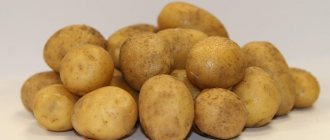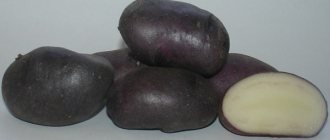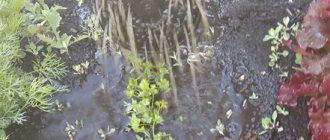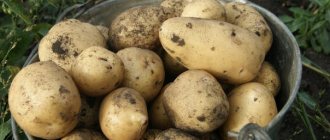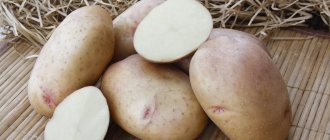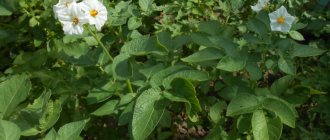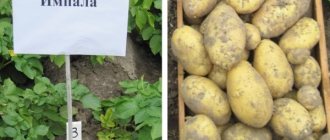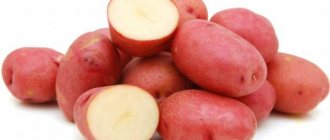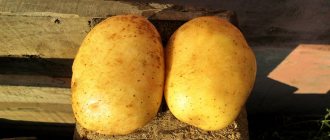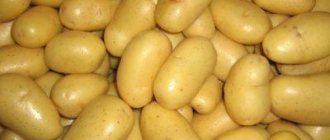Characteristics of Asterix potatoes
The Asterix potato belongs to the mid-late varieties; the root crops reach biological ripeness 120 days after planting the seeds. The fruits can be consumed 60 days after flowering; tubers of technical ripeness do not differ in taste from fully ripened ones. They have a more watery consistency and not fully formed peel. The chemical composition of “young” fruits contains a small amount of starch, so they do not disintegrate during heat treatment.
The Asterix variety is frost-resistant; in the event of night spring frosts, frozen shoots are quickly restored, the damage does not affect the timing of flowering and fruit ripening. Asterix potatoes can go without watering for a long time. Excess moisture in the soil is undesirable for the crop; there is a risk of rotting of the ovary and the lower part of the tops.
The root crop grows on any soil except swampy soils. The yield will be much higher if the composition is light and fertile. The variety is responsive to nitrogen fertilizers, but the high nitrogen content does not affect the size of the fruit in their favor.
Attention! For photosynthesis, the Asterix potato requires a sufficient amount of ultraviolet radiation; in the shade, the plant's growing season is suspended.
External description of the Asterix potato:
- The bush is tall (80 cm), spreading, densely leafy. It is formed by six thick stems; with excess moisture, the tops become fragile and break easily.
- The foliage is dense, dark green, elongated, tapering towards the top. The surface of the leaf plate is hard, corrugated, with clearly defined veins, the edges are wavy, and there is a rare edge.
- The flowers are purple with an orange core, forming panicle inflorescences.
- The fruits are oval-shaped, medium-sized, leveled, weighing between 85–125 g. The bush produces up to twelve ovaries, the arrangement of the fruits is dense and compact.
- The peel is even, smooth, thin, dark red, the eyes are few and superficial.
- The pulp is yellow, dense, juicy, and does not oxidize (do not darken) during processing.
Asterix potatoes practically do not produce small non-marketable tubers, even in weather unfavorable for the crop. It belongs to the table variety of medium friability. The color of the pulp does not change during heat treatment.
Soil preparation
The soil must be fertilized in the fall with humus: 40 buckets per hundred square meters. You can add complex mineral fertilizers to it. The main thing is that the nitrogen content is not high. If there is an excess of it, plants may die.
The ridges are formed at a distance of 60 cm from one another and are oriented from south to north. With this arrangement, the bushes will be well and evenly illuminated all day long. This promotes the formation of chlorophyll and helps the plant get adequate nutrition.
Between planting holes you need to leave 25cm. Place 1 tsp in each well. potassium salt, and phosphates. A handful of ash will protect the tubers from late blight, and a handful of onion peels from small insects and wireworms.
Pros and cons of the Asterix potato variety
Dutch varieties have long found recognition among Russian farmers. The average size of the tubers lends itself well to mechanized harvesting. Asterix potatoes are grown over large areas for the food industry and supplies to the retail chain, the marketability of the variety is 95%. On a personal plot, preference is given to Asterix potatoes because of its advantages:
- high yield;
- good taste;
- universal use;
- frost resistance, can be grown in regions with cold climates;
- heat resistance, this quality is a priority for gardeners from the South;
- storage duration;
- transportability.
Important! After ripening, the root crop can remain in the soil for a long time without losing its presentation and taste.
The disadvantages include weak immunity to viral infection; the disease can destroy the entire planting in a small plot and large farming areas. Potato Asterix does not tolerate waterlogging of the soil; it has low resistance to rhizoctonia and common scab.
Description of the variety
The table presents data on starch content in different varieties:
Description:
- Elongated oval-shaped tubers, smooth skin;
- Red root vegetables have small eyes;
- The average tuber weight is 70-115 grams;
- The pulp is yellow when cut;
- Starch content 17%;
- Tall, straight bush with dark green, medium-developed tops.
Planting and caring for Asterix potatoes
Seeds are planted around the second half of May. The main condition is that the soil warms up at least +16 0C. Focus on the climate characteristics of the region. In southern latitudes, planting work is carried out earlier - at the end of April or beginning of May.
Selection and preparation of a landing site
The place for planting Asterix potatoes is chosen to be open, without fruit trees growing nearby. For photosynthesis, the variety needs a sufficient amount of ultraviolet light. In the shade, the tops form thin, elongated, and flowering is weak. Wetlands with close groundwater and lowlands where water accumulates are not suitable for planting.
The soil is prepared in the fall. The planting site is dug up, the roots of weeds are removed, if the composition is acidic, they are neutralized with dolomite flour, and organic matter is added. In the spring, 2 weeks before planting, the soil is loosened and saltpeter is added.
Preparation of planting material
Late varieties are planted only with germinated seeds. Preparatory work:
- Seeds are selected in the fall; they should be of medium size, weighing 60–70 g, without damage, and of the same size.
- For planting, Asterix potatoes are poured into boxes in the fall and placed in the basement for storage.
- In the spring, the container with seeds is taken out for germination and placed in a lighted room with a temperature of +150 C.
- The sprouts should be thick (2.5 cm).
Before planting, the seeds are treated with a solution of manganese and boric acid.
Landing rules
Asterix potatoes are planted in two ways: in single holes (under a shovel) or in pre-prepared furrows. The scheme is the same for both methods:
- The depth of the hole or furrow is 15 cm, row spacing is 55 cm, between nests is 40 cm.
- The seeds are laid out 8 cm from each other, two pieces per hole.
- Ash and peat are poured on top.
- Cover with earth.
To avoid damaging the sprouts, the tubers are laid carefully.
Watering and fertilizing
If precipitation falls twice a month, additional watering for Asterix potatoes is not required. In case of dry summers, potatoes are watered after planting and 3 weeks after flowering.
Fertilizers (urea, potassium and phosphate compounds) are applied a month after planting. When all the Asterix potatoes have bloomed, they are fed with nitrogen agents. Simultaneously with fertilizing, the bushes are treated with Bordeaux mixture.
Loosening and weeding
The Asterix potato sprouts after two weeks. When the rows are well defined, weeding is done between the rows. The top layer is loosened for better oxygen supply. Weeds are removed from bushes by hand. A repeat event is carried out when the tops reach 15 cm in height. Weeds along with their roots are removed from the site.
Hilling
When the stems grow to 25 cm, Asterix potatoes are hilled. If potatoes are planted in holes, soil is poured from all sides to the top leaves. If the planting was in a furrow, hill up on both sides in the form of a ridge. After two weeks, for better growth of tubers, it is recommended to repeat the procedure. Simultaneously with hilling, the remaining weeds are removed.
Correct fit
Planting and care have their own subtleties:
- "Asterix" has no special preferences in soil types. But it is better to grow it in beds after leguminous crops or perennial grasses;
- Seed material with sprouts is planted at the end of April, in soil heated to +7°C;
- The generally accepted planting pattern is 70 x 35;
- Tubers must be buried to a depth of 7 to 10 cm.
Basic rules of care:
- This variety responds positively to harrowing. It is first carried out five days after planting. Then two more times until shoots appear, and twice more after they appear;
- "Asterix" has a good reaction to fertilizers, especially manure;
- Potatoes need maximum light and air. The soil should be loose and free of weeds;
- Does not require numerous waterings. It only requires watering three times: as soon as the shoots appear, during the period of buds appearing and when the flowering period ends;
- The situation is similar with fertilizing. It is enough to carry out three feedings per season. Use preparations that develop the root system, thanks to which powerful and beautiful tubers will appear.
Diseases and pests
The main disease of the Asterix potato is the Y virus; the pathogen has several strains and is transmitted by insects, most often aphids. This problem is especially relevant in hot, dry summers. Infection manifests itself as necrosis of leaves and tubers, less often as a wrinkled mosaic on the tops. To eliminate the pathogen, the plant is treated with insecticides.
At high humidity and low air temperature, Asterix potatoes are affected by rhizoctonia. A fungal infection appears as black spots on tubers and leaves. The crop is treated with biological preparations: “Baktofit”, “Planriz”. A favorable environment for the appearance of scab is: moist soils, slightly alkaline soil composition, excess organic matter. The fungus infects tubers and manifests itself as hard (corky) brown spots. The problem is eliminated by observing crop rotation and additionally adding superphosphate and sulfur to the soil.
Advantages and disadvantages
Pros:
- long-term storage (more than 8 months) without loss of marketability at 6-7 degrees Celsius in storerooms;
- significant productivity;
- marketability is approaching 90%, the vegetable is cultivated on an industrial scale;
- low susceptibility to a number of infections;
- excellent taste;
- frost tolerance;
- cultivation in the northern regions;
- heat and drought tolerance;
- transportability (the peel prevents bumps and stains);
- dining versatility.
Minuses:
- the need for protection from pests;
- risk of infection with virus Y.
Harvesting and storage
Asterix potatoes are characterized by a long growing season; root crops ripen from late August to September. If the crop is not harvested in a timely manner, the fruits remain in the ground until frost occurs without changes. Harvesting is carried out in sunny weather. The dug up Asterix potatoes are immediately removed from the garden bed, without leaving the tubers in the open. Ultraviolet light triggers the synthesis of solanine, a substance toxic to humans. A green pigment forms on the surface.
The potatoes are put into a darkened room, scattered to dry, and then lowered into the basement. Optimum storage temperature +6 0 C, air humidity 80%. Asterix potatoes can be stored until the end of May without losing their taste and presentation. Before storing, the tubers can be washed; a prerequisite is that they must dry well.
